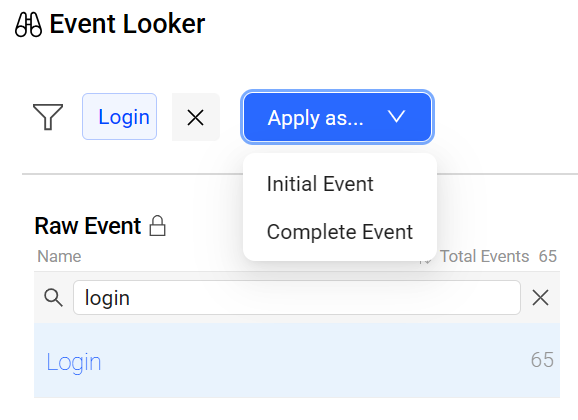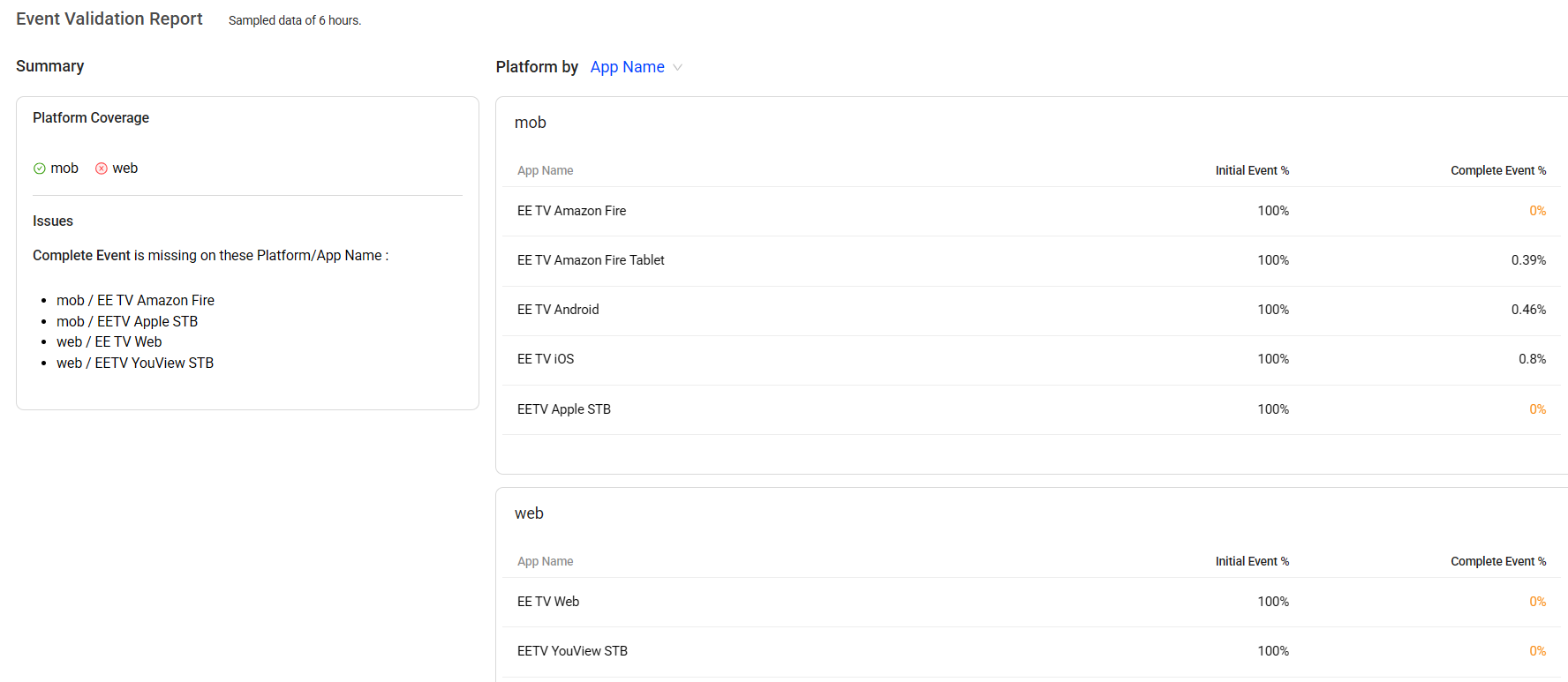Custom metrics are associated with specified initial/follow-up events to analyze data for complex user actions and app performance scenarios, such as analyzing the amount of time spent between viewer login and the start of video playtime, and the success rate of cart uploads to completed purchase.
DPI enables different types of individual metrics. Start mapping from a Conviva predefined event, a custom event, or a combination of both as mapping rules to comprehensively track the desired user behavior.
-
Duration Metric: Measures the time interval between two events, such as the duration between the login screen event and the login success event to measure login durations and quickly respond to impacting login issues.
-
Conversion Metric: Measures the count or conversion rates of events from one stage to another, such as the count of sessions with successful login after opening the login screen to measure the successful login conversion and find highlights to improve user experience.
-
Event Aggregation Metric: Measures the number of events, or calculates the value of event attributes, such as the average duration of network requests to measure the network request performance and do optimization accordingly.
Creating Custom Metrics
-
Start with the location:
-
Activation Home Page
-
Metric Builder
-
Select metric page in Trends
-
-
Enter the metric name, and provide the metric information.
-
(Optional) Metric description.
-
From the Metric Type list, select the desired metric type.
-
-
Select the events based on your Metric Type selection:
-
If you are unsure about the exact events to select, use the tools to identify them:
-
EventLooker: Allows browsing and searching events and tag keys. Use the drop-down list to apply a selected event.

-
LiveLens: Provides real-time event names and tags while interacting with an application. To learn how to use LiveLens, see LiveLens.
-
-
Select events for metric creation. If the events in the drop-down list do not meet your needs, click the Edit icon to make changes.
Note: To measure any network request from a specific page, such as a page whose path contains ‘profile’, use metadata as context to limit the network requests to those originating from that page. Metadata such as Country, Page Path, and Device Name serve as context to ensure that the configured event rule matches the selected metadata, enabling accurate measurement of specific traffic.
-
For Conversion metrics:
-
Initial Event: This refers to the initial event as defined previously.
-
Complete Event: This refers to the follow-up event as defined previously.
For example, to measure the conversion rate from login start to successful login, select Login Process Start and Login Success.
-
-
For Duration metrics:
-
Initial Event: The first event that triggers a particular process or workflow. It serves as the starting point for measuring and tracking user interactions or system behavior.
-
Complete Event: A complete event that occurs after the Initial Event. It is a continuation or a result of the initial action. The Follow-up Event helps track and measure user engagement or system behavior beyond the initial interaction.
For example, to measure the average duration from login start to successful login, select Login Process Start and Login Success.
-
-
For Event Aggregation metrics:
-
Select the source aggregation event.
For example, to measure the total number of application errors, select Application Error.
-
-
-
Validate the event coverage. If the event coverage is not as expected, make updates for the events.
For example, this screenshot shows that the events apply only to the mobile platform. To track the web platform, update the events accordingly.

-
-
Configure metric details based on the metric type you selected.
-
For Conversion metrics:
-
Select the conversion type, Conversion Rate or Conversion Count
-
Calculate Conversion Rate / Conversion Count of successful conversions within a given seconds/minutes/hours: Set a criteria for the desired conversion window (or time boundary/constraint) for the paired events’ occurrence per pairing logic.
As the same events can appear multiple times in an app process, pairing logic specifies the first or last sequential instance of the initial and follow-up mapped events across multiple event instances.
-
First-First Pair: Uses the first Initial Event and the first Follow-up Event as a pair.
-
Last-First Pair: Uses the last Initial Event and the first Follow-up Event as a pair.
For example, if you set Calculate Conversion Count of successful conversions of First-First pair within 30 seconds and the Initial Event is Login Screen View and the Follow-up Event is Login Success, the criteria is that the two events must occur within 30 seconds to be considered a successful conversion.
-
-
Select an option from the drop-down list to define whether a higher or lower metric value is considered positive. For example, choosing Higher is better indicates that a higher value is desirable, whereas choosing Lower is better indicates that a lower value is desirable.
-
-
For Duration metrics:
-
Set pairing logic:
-
Select either of the options:
-
First-First Pair: Uses the first Initial Event and the first Follow-up Event as a pair.
-
Last-First Pair: Uses the last Initial Event and the first Follow-up Event as a pair.
-
-
Choose either first pair or multiple pairs to define count in the same session.
-
first pair: selects only the first pair in a session.
-
multiple pairs: selects all pairs that meet the pairing logic in the same session.
-
 Pairing Logic
Pairing Logic
As the same events can appear multiple times in an app process, pairing logic specifies the first or last sequential instance of the initial and follow-up mapped events across multiple event instances.
For example, suppose you have two mapped events: Login Screen View indicates viewers opening the login page, and Login Success indicates viewers successfully logging into their accounts. In a session, the events are displayed in the following time order: Login Screen View1, Login Screen View2, Login Screen View3, Login Success1, Login Screen View4, Login Success2.

first-first pair last-first pair If selecting first-first pair and first pair If selecting first-first pair and multiple pairs If selecting last-first pair and first pair If selecting last-first pair and multiple pairs Event name Login Screen View1 and Login Success1 Login Screen View3 and Login Success1 Login Screen View1 and Login Success1 Login Screen View1 and Login Success1; Login Screen View4, Login Success2 Login Screen View3 and Login Success1 Login Screen View3 and Login Success1; Login Screen View4, Login Success2 -
-
Select an option from the drop-down list to define whether a higher or lower metric value is considered positive. For example, choosing Higher is better indicates that a higher value is desirable, whereas choosing Lower is better indicates that a lower value is desirable.
-
(Optional) To show the distribution of the metric in DPI, select the Distribution check box and fill out the range. Enabling or disabling the Distribution option for an existing metric does not impact the metric's historical data.
-
-
For Event Aggregation metrics:
-
Set the value calculation type. If you select Total values or Average values, select a tag key from the drop-down list.
-
Number: Sets the value to the count of the source events.
-
Total Values: Sets the value to the sum of the event attribute values.
-
Average Values: Sets the value to the averge or mean of the event attribute values.
-
-
Select an option from the drop-down list to define whether a higher or lower metric value is considered positive. For example, choosing Higher is better indicates that a higher value is desirable, whereas choosing Lower is better indicates that a lower value is desirable.
-
(Optional) Select the Specify the unit of measurement for the collected data check box, and select the required unit.
-
-
-
Click Save and Deploy to complete the deployment.
Note: When updating custom metrics, use the Keep historical data checkbox to control whether existing data is retained. Select the checkbox to keep the data, or clear it to remove it. The checkbox is selected by default.
The deployment takes several minutes to take effect.
DPI Custom Metrics DPI Custom Metrics metric builder metric builder flow flow flow metrics flow metrics